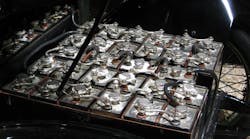Inside its Silicon Valley wafer factory, Linear Technology has installed wireless sensors to monitor gas cylinders used in the manufacturing process and alert managers when to replace them. The chipmaker had little trouble selecting which sensors to buy – it designed them.
The sensors, equipped with wireless technology called SmartMesh IP, have found early success in the industrial Internet of Things, which aims to increase manufacturing efficiency by using sensor data and sharing it between machines. Linear Technology says that over 50,000 SmartMesh networks have been installed in places like GlaxoSmithKline’s factory in Cork, Ireland, where they observe the drug company’s water storage tanks.
But the company’s engineers have a vision of pushing SmartMesh out of its industrial nest. Linear Technology recently said that it helped build a battery management system for electric vehicles using SmartMesh chips and battery monitors. The idea was to cut out the complex and costly wiring that normally connects auto electronics.
The system paired the wireless SmartMesh devices with battery monitoring circuits capable of tolerating lots of electrical noise and wide operating temperatures inside the battery cells of a BMW i3 electric vehicle. The devices, which are about the size of subway ticket, reported the charge of each battery using a wireless technology called mesh networking, which shares wireless signals within a small community of the chips.
The battery management system was built by Lion Smart using components from Linear Technology, which showed the BMW test vehicle at the Electronica trade show in Munich last month. It stands out for using technology that was originally developed to cut costs and make it easier to add cheap sensors inside high-voltage factory environments.
The results were similar in new battery management system, said Erik Soule, Linear Technology’s vice president of signal conditioning products, in a recent interview. The wireless chips eliminate the wires that normally deliver battery readings to a central computer, improving reliability and simplifying designs. There is a constant threat that the wires will shake loose or fail while driving.
The power required to drive electric cars is not usually contained in a single large battery. In the BMW i3, for example, two separate battery packs are located in the front and back of the vehicle. Reporting their status to a central point normally falls to wires, like the popular CAN Bus cable or a proprietary technology like Linear Technology’s isoSPI cable.
SmartMesh takes the cables out of the equation, allowing engineers to install the battery packs and sensors where wiring harnesses can’t fit, Soule said. Getting more data about the batteries, like current and temperature, is as simple as adding more sensors. The wireless chips are also cheaper than the cabling, he said.
There are many potential stumbling blocks to using wireless technologies inside cars, Soule said. Electric cars are not safe environments for wireless signals. There are many metal parts that could prove difficult for wireless signals to get through and the high voltage electronics create tons of electromagnetic noise.
But SmartMesh uses both path and frequency diversity that routes the messages around obstacles as well as dampen interference. It is also constantly watching the network so that it can hop between channels when one gets too crowded. Linear Technology boasts that SmartMesh networks are %99.999 reliable.
The system has its limitations, though. Soule cautioned that SmartMesh doesn’t have the response times to stream data from critical sensors like radar or cameras that could help a vehicle automatically avoid a collision. The devices, which can synchronize their clocks to within several microseconds, were originally developed for factories and environmental sensing, prioritizing reliability and low power consumption over speed.
The concept of using wireless sensors inside cars also has history working against it. In 2010, researchers found that hackers could hijack the wireless pressure sensors built into the tires of some luxury vehicles. The researchers warned that criminal could exploit the vulnerability to track a vehicle or force its electronic control system to malfunction.
Soule points to SmartMesh’s AES128 encryption as a thick insulation against hackers, but he also admits that the system is still a proof-of-concept. He said that he talked with representatives from several German automakers at the Electronica demonstration. “There is huge interest,” he said.
Linear Technology acquired SmartMesh through its acquisition of Dust Networks in 2011, on the premise that its sensor networking chips could provide a wider audience for the power management chips for which it is known. The technology has kept a low profile in the $14.7 billion deal that Linear Technology signed in May to be acquired by Analog Devices, which is increasingly courting factories and cars with its chips.

